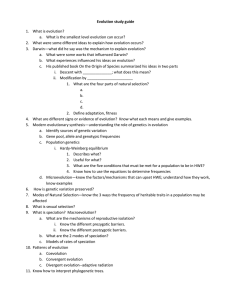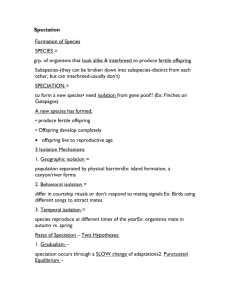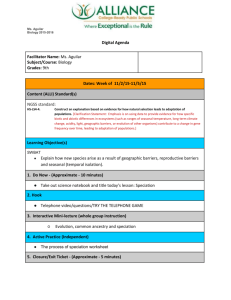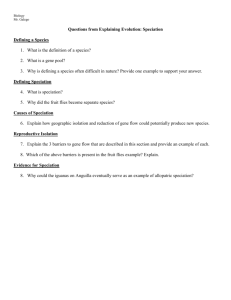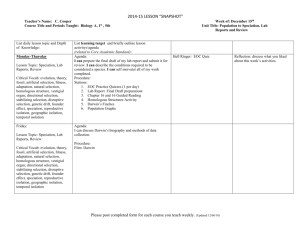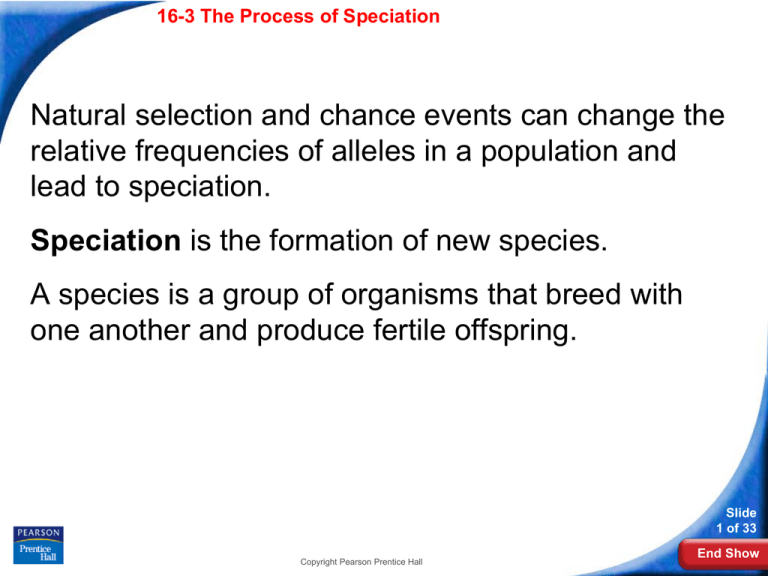
16-3 The Process of Speciation 16-3 The Process of Speciation
Natural selection and chance events can change the
relative frequencies of alleles in a population and
lead to speciation.
Speciation is the formation of new species.
A species is a group of organisms that breed with
one another and produce fertile offspring.
Slide
1 of 33
Copyright Pearson Prentice Hall
End Show
16-3 The Process of Speciation
Isolating Mechanisms
What factors are involved in the formation
of new species?
The gene pools of two populations must
become separated for them to become new
species.
Slide
2 of 33
Copyright Pearson Prentice Hall
End Show
16-3 The Process of Speciation
Isolating Mechanisms
Isolating Mechanisms
As new species evolve, populations
become reproductively isolated from each
other.
When the members of two populations cannot
interbreed and produce fertile offspring,
reproductive isolation has occurred.
Slide
3 of 33
Copyright Pearson Prentice Hall
End Show
16-3 The Process of Speciation
Isolating Mechanisms
Reproductive isolation can develop in a variety of
ways, including:
• behavioral isolation
• geographic isolation
• temporal isolation
Slide
4 of 33
Copyright Pearson Prentice Hall
End Show
16-3 The Process of Speciation
Isolating Mechanisms
Behavioral Isolation
Behavioral isolation occurs when two populations
are capable of interbreeding but have differences
in courtship rituals or other reproductive strategies
that involve behavior.
Slide
5 of 33
Copyright Pearson Prentice Hall
End Show
16-3 The Process of Speciation
Isolating Mechanisms
Geographic Isolation
Geographic isolation occurs when two
populations are separated by geographic barriers
such as rivers or mountains.
Slide
6 of 33
Copyright Pearson Prentice Hall
End Show
16-3 The Process of Speciation
Isolating Mechanisms
Geographic barriers do not guarantee the formation
of new species.
If two formerly separated populations can still
interbreed, they remain a single species.
Potential geographic barriers may separate certain
types of organisms but not others.
Slide
7 of 33
Copyright Pearson Prentice Hall
End Show
16-3 The Process of Speciation
Isolating Mechanisms
Temporal Isolation
Temporal isolation occurs when two or more
species reproduce at different times.
Slide
8 of 33
Copyright Pearson Prentice Hall
End Show
16-3 The Process of Speciation
Testing Natural Selection
in Nature
Testing Natural Selection in Nature
Studies showing natural selection in action involve
descendants of the finches that Darwin observed
in the Galápagos Islands.
The finches Darwin saw were different, but he
hypothesized that they had descended from a
common ancestor.
Slide
9 of 33
Copyright Pearson Prentice Hall
End Show
16-3 The Process of Speciation
Testing Natural Selection
in Nature
Slide
10 of 33
Copyright Pearson Prentice Hall
End Show
16-3 The Process of Speciation
Testing Natural Selection
in Nature
Slide
11 of 33
Copyright Pearson Prentice Hall
End Show
16-3 The Process of Speciation
Testing Natural Selection
in Nature
Peter and Rosemary Grant tested Darwin’s
hypothesis, which relied on two testable
assumptions:
• For beak size and shape to evolve, there must be
enough heritable variation in those traits to
provide raw material for natural selection.
• Differences in beak size and shape must produce
differences in fitness, causing natural selection to
occur.
Slide
12 of 33
Copyright Pearson Prentice Hall
End Show
16-3 The Process of Speciation
Testing Natural Selection
in Nature
The Grants tested these hypotheses on the medium
ground finch on Daphne Major, one of the Galápagos
Islands.
During the rainy season, there is plenty of food.
Slide
13 of 33
Copyright Pearson Prentice Hall
End Show
16-3 The Process of Speciation
Testing Natural Selection
in Nature
During droughts, food becomes scarce.
Individual birds with different-sized beaks had
different chances of survival during a drought.
Slide
14 of 33
Copyright Pearson Prentice Hall
End Show
16-3 The Process of Speciation
Testing Natural Selection
in Nature
When food was scarce, individuals with large beaks
were more likely to survive.
Slide
15 of 33
Copyright Pearson Prentice Hall
End Show
16-3 The Process of Speciation
Testing Natural Selection
in Nature
The Grants provided evidence of the process of
evolution.
Beak size can be changed by natural selection.
Slide
16 of 33
Copyright Pearson Prentice Hall
End Show
16-3 The Process of Speciation
Speciation in Darwin's Finches
Speciation in Darwin's Finches
Speciation in the Galápagos finches
occurred by:
• founding of a new population
• geographic isolation
• changes in new population's gene pool
• reproductive isolation
• ecological competition
Slide
17 of 33
Copyright Pearson Prentice Hall
End Show
16-3 The Process of Speciation
Speciation in Darwin's Finches
Founders Arrive
A few finches—
species A—travel
from South
America to one of
the Galápagos
Islands.
There, they survive
and reproduce.
Slide
18 of 33
Copyright Pearson Prentice Hall
End Show
16-3 The Process of Speciation
Speciation in Darwin's Finches
Geographic Isolation
Some birds from
species A cross to
a second island.
The two
populations no
longer share a
gene pool.
Slide
19 of 33
Copyright Pearson Prentice Hall
End Show
16-3 The Process of Speciation
Speciation in Darwin's Finches
Changes in the Gene Pool
Seed sizes on the
second island
favor birds with
large beaks.
The population on
the second island
evolves into
population B, with
larger beaks.
Slide
20 of 33
Copyright Pearson Prentice Hall
End Show
16-3 The Process of Speciation
Speciation in Darwin's Finches
Reproductive Isolation
If population B birds cross back to the first island,
they will not mate with birds from population A.
Populations A and B are separate species.
Slide
21 of 33
Copyright Pearson Prentice Hall
End Show
16-3 The Process of Speciation
Speciation in Darwin's Finches
Ecological Competition
As species A and B compete for available seeds
on the first island, they continue to evolve in a way
that increases the differences between them.
A new species—C—may evolve.
Slide
22 of 33
Copyright Pearson Prentice Hall
End Show
16-3 The Process of Speciation
Speciation in Darwin's Finches
Continued Evolution
This process of isolation, genetic change, and
reproductive isolation probably repeated itself often
across the entire Galápagos island chain.
Slide
23 of 33
Copyright Pearson Prentice Hall
End Show
16-3 The Process of Speciation
Studying Evolution Since
Darwin
Studying Evolution Since Darwin
Scientific evidence supports the theory that living
species descended with modification from common
ancestors that lived in the ancient past.
Scientists predict that as new fossils are found,
they will continue to expand our understanding of
how species evolved.
Slide
24 of 33
Copyright Pearson Prentice Hall
End Show



